Advice on diagnostic-test &
general auto-electrical repair equipment
![]()
Page updated 16-08-23
(28-05-23). Not updated this page for years - so here we go - everything below the "dotted line" is history - Autel or Launch from China is where it at for the idependant motor repairer in 2023 - scopes have had thier day except for a few applications. Pass thru J protocol is here - plus an array of VIN assigned parts. Vehicles are now not stand alone devices - there are now networked to the supplying factories servers.
................................................................................................................................................................................................................................................................................
Fault code reading can be very mis-leading. Even with the latest and most expensive kit or main dealer equipment, communication between diagnostic reader & the EEPROM chip, where the info is stored, is not always possible. Even when possible, faultcode reading may point to sensor failure, when in fact the sensor is reading correctly, the problem is something else. Faultcode reading must only be seen as a diagnostic method "to point the finger in the right direction". To trust faultcode reading or live serial data as your only means of diagnostics, will mean allot of wasted time & money buying un-wanted sensors.
Delph DS150E or an Autocom Pro connected to a secondhand BT Panasonic CF 29 toughbook. (22-02-14).
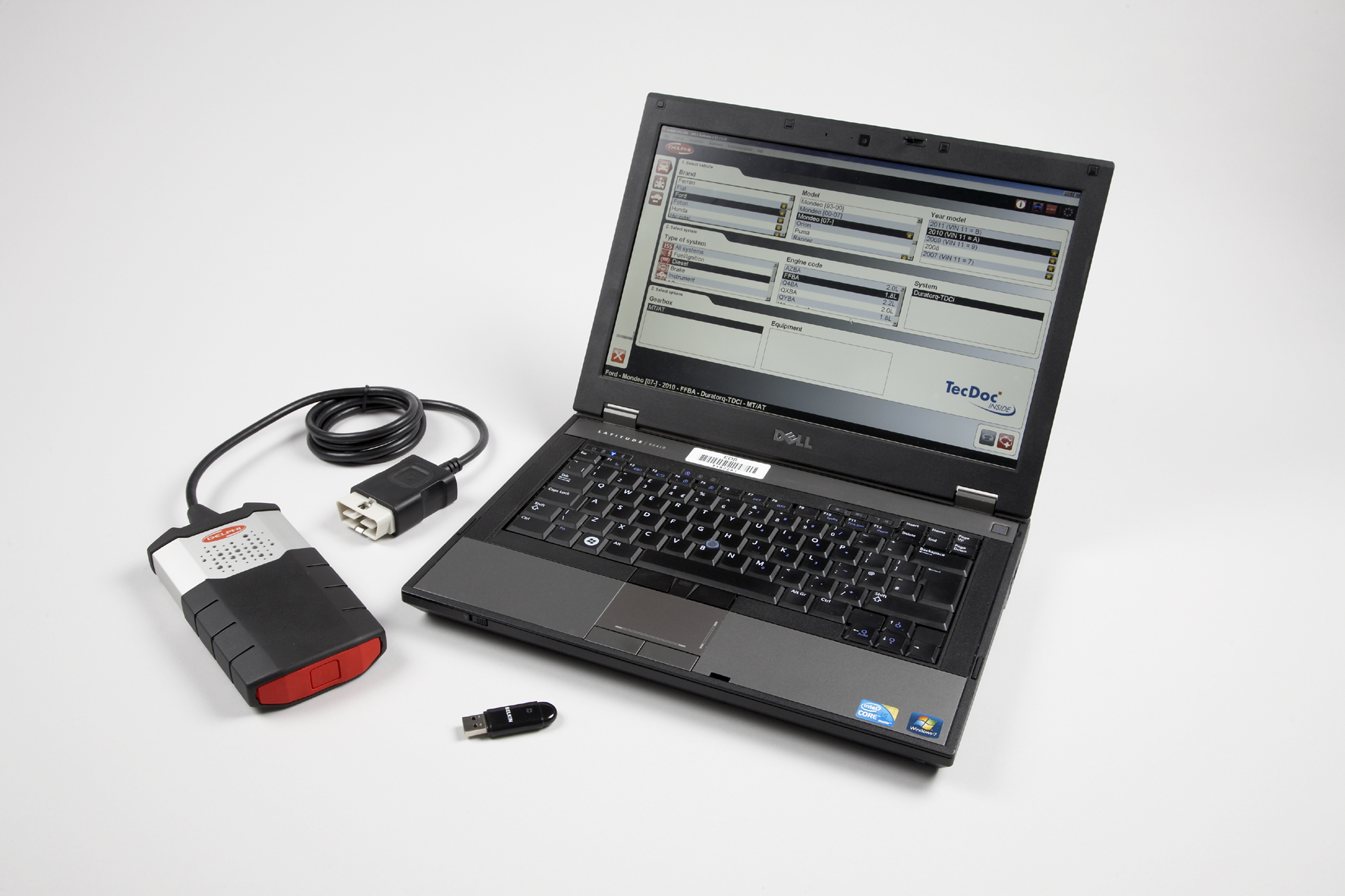 Delphi DS150E
Delphi DS150E
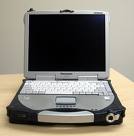
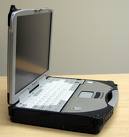 Panasonic Toughbook (my new toy)!
Panasonic Toughbook (my new toy)!
SP Diagnsotics equipment is as good as anything for the money, if you buy secondhand. SPi with one SD card and a collection of leads, is the only relevant model sold. The older Sykes Pickavent ACR4 MAP pod is very good for older cars.
(07-02-11) Sykes Pickavant and SP diagnostics are now two differing companies. SP diagnostics is led by Winston Lee, who worked for Sykes since the early 1990's. He has survived many changes of Sykes ownership over the years. So he must be a man who knows his trade! SP diagnostics have taken over all the design, manufacture and customer support of the former Sykes diagnostic products.
Sykes Pickavent SPe service tool, just being released looks very usefull, I have the application list! It looks good. The base tool is a rebranded Socio Pokayoke 540 product from Italy. This tool is aimed in mainland Europe, at the fast fit trade (07-02-11). Price is £1695 + VAT it looks very good value for money. One of the big motor factor chains has offered me one at £1450 + VAT (22-02-11).
(07-02-11) SP diagnostics have launched the Service Scan which is a product that is comparable in operation to the SPe but is £995 + VAT. www.servicescan.co.uk
(31-10-11) We bought in August of this year a secondhand SPi unit. We are really pleased with the SP Diagnostics SPi we have bought, the multiplexed all in one 16pin lead has really speeded up the job. Ford diagnostics much improved, comes with a bit of Dealer spec IDS type graphing. All in one lead must save me about 30 mins a day on average. EOBD applications are very good, with some really impressive graphing functions. We now have the latest Software update for the SPi downloaded from the SP website.
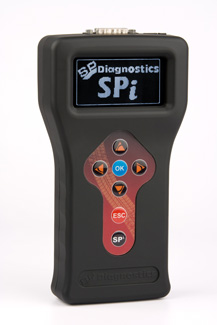 SPi
SPi
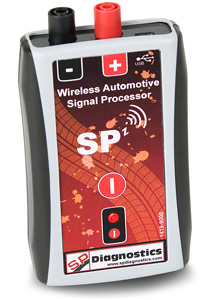 Wasp
Wasp
The SP diagnostics WASP unit, looked too much like overkill to me at £200 ish. I have had the opportunity to try one a few times and I am beginning to find uses for it. (31-10-11). If you own a SP Wasp, you need a good supply of cable ties, I today have diagnosed an intermitant ABS fault on an Audi RS6. When test driving, I was unable thru live serial data to see the loss of a rear wheel speed sensor signal. I could not use a scope connected to the vehicle wiring and drive at 40mph, but I could use the Wasp and see the sensor output graphed thru the SPi handset. Real success, defined results. I see a future for this type of tool. (24-12-11)
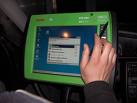

 Bosch KTS 651
Bosch KTS 651
We have owned a Bosch KTS 651-750 which cost us thousands, plus you need to enter into a contract for monthly updates. We would not invest £7k+ in the Bosch KTS system again, as most applications can be covered by separate handheld kit purchased from the internet. If you have a separate scope & OBD2 EOBD CAN-2A enacted faultcode reader & a bit of know-how, you can get round most engine related problems. Even if you have to pay the main dealer an odd hours labour to programe things up, its not too much of a loss. Be warned! No one bit of kit however expensive it is, will do all applications. Another comprehensive bit of kit is VIXEN as used by the AA, it's loaded onto a Panasonic Toughbook. We've used this to some success, getting hold of a copy of this may prove very difficult thou. Forget Snap-on scanners & Crypton code readers. Software & updates just not up to the expensive price tag. Launch systems are easy to use, but daily updates over the internet seems a bit excessive. We have used most systems, none are as good as the marketing literature & salesman say they are! Basically if you have a laptop, go on eBay & you are very handy with a PC, all serial data extraction software is available, at very low cost.
Hold this thought... "I reckon there is more money selling diagnostic equipment than buying it and billing the service out". So be very careful how you spend your money!
Over the years. We have borrowed or bought into many dealer spec systems like: Ford IDS, Jaguar/Land Rover IDS, BMW GT1-OPS-SSS-DIS, Merc Das Star, Tech2 (Vauxhall, Saab, Suzuki and Isuzu), Fiat Examiner, Peugeot Planet-Diag2000, Renault Clip, Citreon Proxia-Lexia3, Rover and Land Rover Testbook, Volvo Vida-Dice, Honda Him-Hds, Nissan Consult2, Toyota Mastertech, Mitsubishi MUT2, VAG-VAS5051, Kia GDS Global and Hyundai Carmen Scan. All were very expensive. The question you need to ask yourself is: Will you ever earn enough money out of them to cover the purchase price and updates. The truthful answer is: Very very unlikely... The MercStar 06 Compact-3, we paid a fortune for it from Europe. Yes it works well, but it has its limitations & we will never earn enough from it to cover the purchase price and because we are not in the Mercedes MUX network, SCN cluster programming is limited up to 2006 & non existent beyond, thus we have not bought an upgrade. We are slowly selling off most of our dealer spec equipment. The return never justifys the outlay.
Land Rover Disco 2, Defender and Range Rover diagnostics. Forget IDS or Testbook. Nanocom at £300 from Cyprus http://blackbox-solutions.com/ Does everything you need including programming keys. I have one for my 2004 TD5 Discovery 2. (20-04-14)
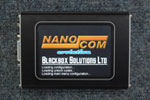
I have just purchased a secondhand Carman-scan for Japanese cars. Nextech Carman-scan-lite with Version 980 software onwards and the optional blue multigateway cable which performs single wire can-bus, is the model to buy! Price is about £1900 new. (22-02-11).
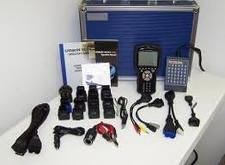 Our Nextech Carman Scan Lite (sold now)
Our Nextech Carman Scan Lite (sold now)
We have just replaced our Carman scan lite with an ADL G Scan 2 TAB with a tablet which is OEM dealer spec coverage for Kia and Hyundai for £895 + VAT (23-07-17). G Scan 2, this tool at £1795 + VAT (23-07-17). Buy your own tablet and save £900 + VAT, simple....
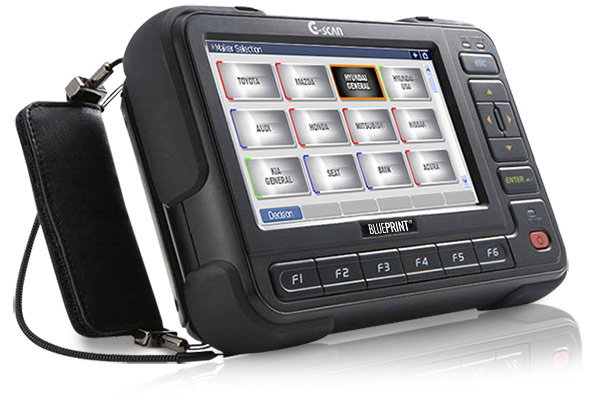
I have also bought a Bosch KTS200 for £1674 inc VAT. This was a non time out software model ex Hickleys Diagnostics, Taunton, Somerset (12-09-16).

Mac Tools (USA) sell the ET50 EOBD CANII compliant mini code reader-eraser for $69.99 US, which is about £36ish plus P+P (25-01-08). I've bought one direct from the USA. It's a super little pocket sized tool, it works very well, never needs batteries & is going to save me lugging about my laptop when rechecking & erasing codes after a repair has been enacted. Its the only mini code-reader I've seen, that does not look like its going to fall apart the first time you use it. Time will tell....? (24-01-09). Mac ET50 super tool for the money. It will erase some codes my Sykes SPi & ACR4 will not. Only downside is the auto scroll HMI function is a bit frustrating till you become familiar with the tool. These are now available as copies from China from eBay for less than £20 (21-08-11)
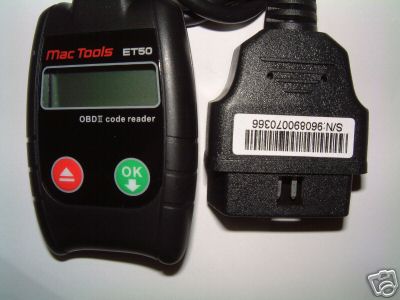 Mac
ET50
Mac
ET50
Another useful Can2 compliant code reader is the OTC 3109. Very-very robust tool. We have one in our recovery truck. Cost is about £105 (better value than comparable Sealey or Autel tools). Plus the OTC tool is upgradeable, free from there website! Sykes Pickavant are now selling a range of low spec OTC diagnostic tools (07-01-12).
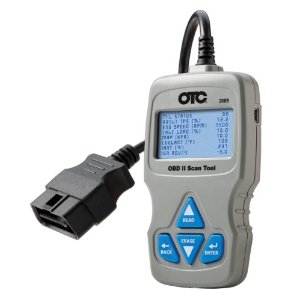 OTC 3109 CAN code reader.
OTC 3109 CAN code reader.
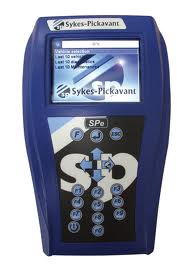 Sykes SPe
Sykes SPe 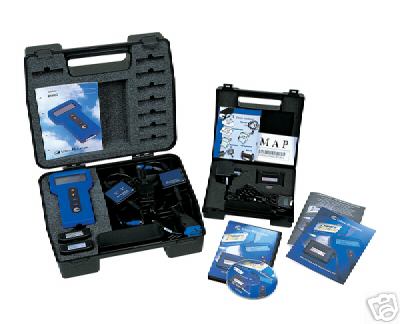 ACR4 MAP kit
ACR4 MAP kit
If you buy any faultcode reading kit, it must be Can compliant and be able to read the new type 29 bit identifiers (Can 2.0B) as well as the old 11 bit identifiers (Can 2.0A). Even if you don't understand this, it is a question you need to ask when buying diagnostic equipment.
Don't dabble with programming, we caught a cold with Siemens software for BMW. It kept crashing, simple additions (nodes) to can-bus systems for PDC enacted by BMW main dealers, ended up with cars being driven into the workshop for the job and then subsequently being towed away. The simple reason being the software did not work. You have been warned... Any re-programming is best undertaken by the main dealer. Simple reason is, if it goes wrong its down to them! Paying a main dealer for one or two hour's labour, is nothing compared to the risks involved. Any "run of the mill" programming to position of diesel injectors and the like, can be overcome by searching the internet and buying pre-programmed parts from pattern part manufacturers. Key programming & auto locksmithing is a discipline on its own. If you have the Sykes Map kit, for £375-400 they do an additional pod (iKeys) that covers most common applications. Any job that this kit does not cover, we call in a mobile auto locksmith. We do not get enough key programming work to justify £5-7k on more comprehensive kit, Advance Diagnostics being the market leader in chip cloning kit. Avoid EDC15-16 flashing, lots of expensive damage can be done to diesel control systems using poor quality equipment & software.
Re-mapping... If you think you can improve on the balance of performance, fuel economy and reliability. Which is programmed in by the big car manufacturers with billion pound development budgets. You are kidding yourself! (08-02-14). Re-mapping equipment has its uses, these are as follows. DPF delete, dropping EGR valves, Imo defeat. Keeping cars out of limp mode by changing diagnostic parameters.
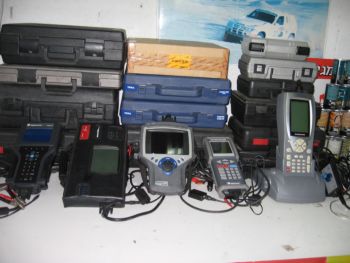 Our expensive heap of dealer spec scanners!
Our expensive heap of dealer spec scanners!
Serial data output (sensor graphing) via the old style K+L-line, or the newer superior Can hi-low terminals of any diagnostic socket, K-line outputs have a data rate of 10400bps where Can2.0A is 500.000bps and Can2.0B is 1.000.000bps. Output that is supplied by the ECU & displayed by, Bosch KTS, later Snap-on & main dealer spec diagnostic equipment including Merc Star. It's all unreliable & misleading. Apart from adding cabling and test equipment to the circuit in question thus increasing the margin of error. It does not exclude the host vehicle cabling, where over 50% of the faults are situated. Any volt drop or resistance in the host cabling will alter the results, giving the impression a perfectly functioning sensor is at fault. Plus with Can-Lin networks, any data transfer glitch will show as complete network failure. When in fact the definitive but time consuming method is to backprobe both ends of all of the network links between the multiplexers (nodes) with a dual channel oscilloscope, comparing the stored waveforms, subsequently they need to be identical for the system to work. I do view serial data on dialy basis for dignosis, but I always test at the point of connection before parting with my money on parts. (08-02-14)
CAN-LIN BUS As a matter of info, most people fear Can-Lin bus systems, but in fact they are very simple & reliable. All network inputs/outputs are testable & most faults are caused by glitches which can be traced back to electrical interference (noise) from high output coils, ignition, central locking solenoids etc. etc. Some early systems lacked shielding and had little or no thought put into where the can-bus cables were routed. Higher or lower frequency interference (noise) will be very evident when comparing waveforms recorded on to an oscilloscope. Mildly damp connections cause problems, they don't need to be wet or corroded, just damp! Forget WD40 or duck oil, use compressed air from an airline fitted with water trap to dry connectors. (08-02-14)
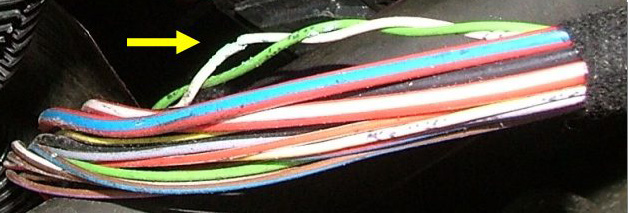
Can-bus wiring fault (twisted pair)
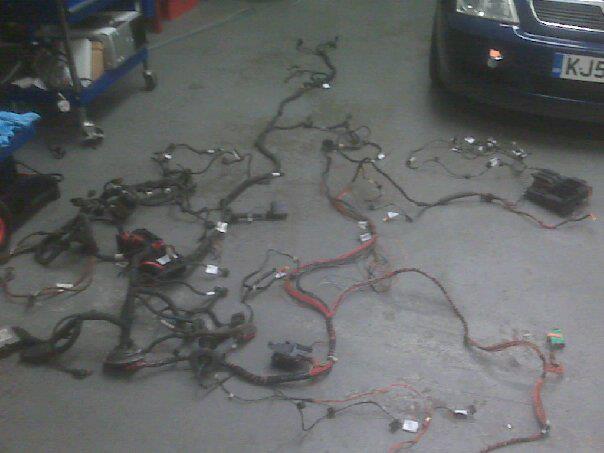
Whole loom out for testing!
Oscilloscopes are the definitive method of sensor testing. The use of an oscilloscope will prove if the sensor in question is malfunctioning or if the host supply wiring or power supply is at fault. We own a 20mhz Picoscope, a colour screen 200mhz non automotive Fluke Scopemeter and an automotive Bosch 50mhz PMS100 with a full set of twelve secondary ignition leads, split thru a 12 way to 2 channel switch-able breakout box. But a more cost effective alternative for your first outing with a scope, is a Velleman HPS10 Personal Scope. The Velleman HPS10 scope costs about £80.00 at the date of writing (we paid £70.00 in a sale) plus £15.00 for a case (well worth the money in workshop environment) £7.50 for five Ni-Mh 2000mh rechargeable batteries and £5.00 for a 12v 500mh regulated power supply (or 9v 300mh unregulated, the scope has an internal charging circuit). Total: £107.50ish (22-05-06). Its a bit cheap and plastic but very portable, the probe is flimsy (replacement £15ish). The case resembles a cheap mobile phone case, but protects the LCD screen from scratches. But with a 10mhz analogue bandwidth you will be able to backprobe and prove most sensors, making up some breakout adapters from old male/female multiplugs plugs will ease connection. It is possible to prove AC ABS wheel sensors, but not some high speed GM crank/cam motion sensors. The tiny non back light LCD display takes some getting used to, I've had to resort to a AA maglite in my mouth before to illuminate it. But never the less it shows you the information you need, voltage from the sensor, over time. With this scope and a bit of ingenuity making up connections, you will be able to prove, MAF, temp, pressure, piezo, motion, position, voltage, Can-Lin bus and hall effect sensors. The HPS10 has auto setting mode, so press one button and it will make all the adjustments for time div, volt div, trigger. It also has manual settings & storage for when you have read the instructions! Oh... If you think 10mhz analogue bandwidth does not sound allot, look at the spec sheet for a Pico or Snap-on automotive oscilloscope, you'll be pleasantly surprised at the spec of the Velleman scope. Velleman also list a HPS40 scope, which is four times faster and has a back light display, but it is well over four times the price. I would not pay the extra for the speed, that is not necessary for automotive diagnostic work.



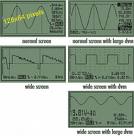 Velleman HPS10 £80 ish
Velleman HPS10 £80 ish
 CZ Sincro DSO200 £230 ish
CZ Sincro DSO200 £230 ish
![]() PDF file in Italian containing illustrations of Velleman scope,
be patient file takes a long while to load. Re-badged by CZ Sincro with a
range of automotive connectors. Most of which can be made up, using
standard BNS connectors, shielded coax (sky cable) and male-female auto'
multiplugs sourced ex scrapyards or new. Solder these all together to
make breakout adapters, to leave sensor in circuit while taking reliable
readings
(18-03-07
I should have marketed it myself & made some money, I've been telling everybody
for over a year how good the scope is, now a mainstream test equipment company
is selling it, at an inflated price with expensive attachments).
Expensive inductive scope
adapters make it
easier to make a connection. Large back light screens are nice, dual
or quadruple channels are good for comparisons. Triple channels are needed for proving
three phase motorcycle generators, which no-one dares load up to much to test. Power/amps scopes have their
uses. PC connections and optical outputs with large memories all come in
handy. Faster mhz scopes are indispensable for high speed cam sensors on very
late model cars (GM). But for simple proof that an automotive sensor is working,
volts over time, from 5secs div and faster is all you need.
Considering the fact we own, two
£2000-4000 oscilloscopes, you would be surprised how much we use the little Velleman scope, its not much bigger than a large graphing multimeter.
PDF file in Italian containing illustrations of Velleman scope,
be patient file takes a long while to load. Re-badged by CZ Sincro with a
range of automotive connectors. Most of which can be made up, using
standard BNS connectors, shielded coax (sky cable) and male-female auto'
multiplugs sourced ex scrapyards or new. Solder these all together to
make breakout adapters, to leave sensor in circuit while taking reliable
readings
(18-03-07
I should have marketed it myself & made some money, I've been telling everybody
for over a year how good the scope is, now a mainstream test equipment company
is selling it, at an inflated price with expensive attachments).
Expensive inductive scope
adapters make it
easier to make a connection. Large back light screens are nice, dual
or quadruple channels are good for comparisons. Triple channels are needed for proving
three phase motorcycle generators, which no-one dares load up to much to test. Power/amps scopes have their
uses. PC connections and optical outputs with large memories all come in
handy. Faster mhz scopes are indispensable for high speed cam sensors on very
late model cars (GM). But for simple proof that an automotive sensor is working,
volts over time, from 5secs div and faster is all you need.
Considering the fact we own, two
£2000-4000 oscilloscopes, you would be surprised how much we use the little Velleman scope, its not much bigger than a large graphing multimeter.
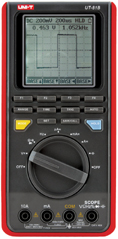 UNI-T UT81B scopemeter
UNI-T UT81B scopemeter
Another very useful hand held mini scope is the UNI-T UT81B. It's available via eBay from china for about £100 including postage from China. The functions are very similar to the Velleman HS10. But the case, control switches & interface look far more robust, plus it has a USB output for connection to a laptop. My friend owns one & I've used it many times in his workshop. Should I ever need to replace my Velleman. This would be the tool of choice! Its been two years since I purchased the Velleman HS10. But even after two years and costing an extra £30, the UT81B scope has a slightly lower bandwidth (speed) of 8MHz compared to 10MHz for the HS10. Just shows what a super value tool the Velleman HS10 scope was in 2006. (22-08-08)
Scope adapters for connection to laptops. Pico is the market leader. We own a non automotive 200/20 Pico. Don't discount Pico non automotive scopes. The only advantage offered by Pico automotive scopes over non automotive scopes is the software has pre-set probe settings for automotive use. These settings are easily installed in Pico non automotive software. I have used several automotive Pico two and four channel automotive scopes in the past and on no single occasion have I ever used more than two channels at once. Even when ignition testing V12 Aston Martin engines, I always use a 12 way to 2 channel switch-able breakout box. Don't get talked into a four channel scopes from Pico or the Bosch FSA450, they are just a waste of money! If you are comparing allot of waveforms, use the storage/playback functions. Pico Beta version software is excellent & can't be bettered for recording & storing waveforms, plus its available as a free download. PicoLog software will not work with Pico Automotive scopes, which is a shame, because its excellent. Send for the Pico catalogue, it has loads of ideas for connections & adapters, their demo CD has plenty of info of auto waveforms. Pico also sell the a excellent coil in cap probe for ignition waveforms for £117.50 delivered (28-04-07) its the best adapter of its kind available anywhere. Laptops are not good for auto repair. They are just too fragile for resting on top of a car wing or front seat. Unless you find a Panasonic Toughbook laptop going cheap, they are indestructible but expensive. Any normal laptop used for diagnostic work, must be viewed a sacrificial. If you do use a laptop for Kv ignition testing, remember to remove the battery & connect it to a mains extension lead which has a good earth, unless you want an unexpected shock sooner or later! Earthed coax leads to the vehicle battery are another good idea, to save stray EMF spikes from ignition systems killing your laptop. I've had some vile momentary static discharge electric shocks from oscilloscopes over the years, mostly from CDI-DIS-Coil ignition systems. All thou it has to be said, most modern equipment is fail safe. Its the accessories and "home made leads" you have to be careful of. Remember to earth them, placing the earth connection nearer the probe than the test instrument. I like Pico scopes, software & accessories, they are a good reliable company offering an excellent product, downside is the price tag is high. Similar or higher specification scope adapters, manufactured in China can be purchased at a fraction of the price. Plus with a bit of thought most adapters can be made up, at a fraction of the cost! If you fancy experimenting with a laptop oscilloscope adapter, Maplin sell a low spec single channel scope adapter for £99. Downside is the software included is very low spec, upside it does have a bandwidth of 12Mhz. But £99 is not allot of money to have a play & self learn a new skill.
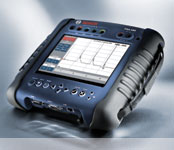 Bosch FSA 450
Bosch FSA 450
 Fluke Scopemeter
Fluke Scopemeter
If you don't feel like wasting your money on purpose made automotive oscilloscopes from Snap-on (Sun), Sykes Pickavant, Mac, Pico, OTC, Bosch FSA450, Vetronix, Crypton or the discontinued Fluke 98-2 or Bosch PMS100. They are just "badged-up" over priced scopes, with auto waveforms programmed into their memories. The only specifically made automotive oscilloscopes I would recommend for the beginner, who is unsure of the settings on a non-automotive scope is the Summit SMD740A, its a good simple tool, with a fair sized LCD screen for about £550ish (28-04-07) downside is it only has an analogue bandwidth of 500khz. But it has a pre-programmed memory and it is a third of the price of "big named scopes". Also if you can find a good secondhand example from the USA, the discontinued UEI ADL-710 was simple and was very good value at about £400 when sold new.
If you can't or won't run to the price of an expensive colour Fluke Scopemeter and to be honest, I would not again! Mine was once new, it now looks like its been to war! Other useful non automotive portable battery powered LCD oscilloscopes which can be purchased secondhand ex eBay for about £100-£200 include the Tektronix THS720-TDS220, Hitachi VC5460 & the tiny mains powered high spec Philips PM3308. Any large cathode ray oscilloscope made by Gould, Philips, Tektronix, Hameg, HP, Rigol, Telequipment, Iwatsu, Thurlby, Sefram, Goldstar & Farnell from the last two decades, designed for TV/Video repair can be used for automotive use. As long as you understand how to set one up, every local library has a book on the subject. They are available from eBay for about £50ish plus postage (12-04-07). Upside is they all have dual channels, most have high frequency settings & storage. Downside is they need a 240V supply and with short leads they are awkward to use under a car bonnet with the engine running! Most only work up to 5v>div so you need 10x probe with BNS tip adapter or a 20x ish attenuator to make up your own leads up with.
Another cheap automotive two channel lab scope adapter is the AES CJ-Max connected to a PDA (Palm pocket computer). I have never used one, but the spec looks good. Pocket computers are by nature highly portable have excellent back-lit colour screens. They are cheap secondhand & will run from 12v supply with readily available adapters, if you have an old PDA with a duff rechargeable battery. Some even have expandable memories. All are connectable to your main desktop PC. AES also sell an OBD-2 scanner kit called the CJ-2, thou it is very expensive for what it is, considering it is not CAN enabled and a bit dated now. Neutronics & Robinair in the USA offer air conditioning diagnostic kits for connection to PDA's.
Any serious auto electrician owns and understands how to use a scope nowadays. Lots of main dealer franchises, are not equipped with one. I think they just prefer to bill customers for loads of parts they don't need. Instead of testing the component is question. Please please don't ignore the oscilloscope, or be frightened off one, believing they are complex to use. If I had to make the choice between owning an oscilloscope or faultcode reading equipment, I would choose a scope every time!
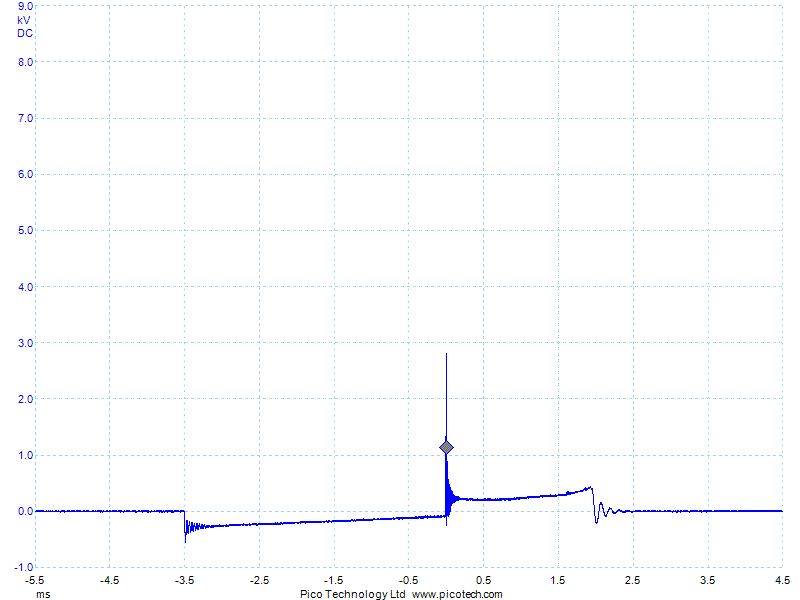
PicoBeta software is excellent for recording & storing waveforms (it can't be bettered). See ignition pattern above from BMW M3 (E36)
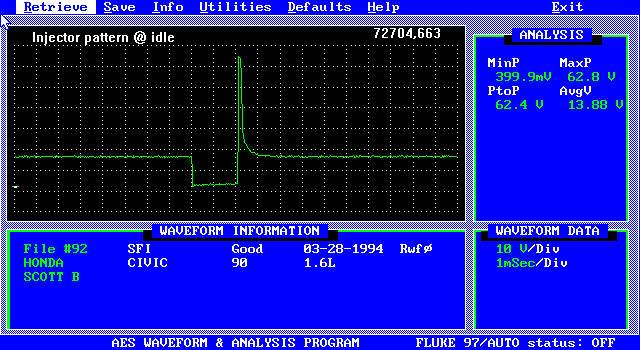
AES program for Fluke 97-98 series & Bosch PMS100 scopes.
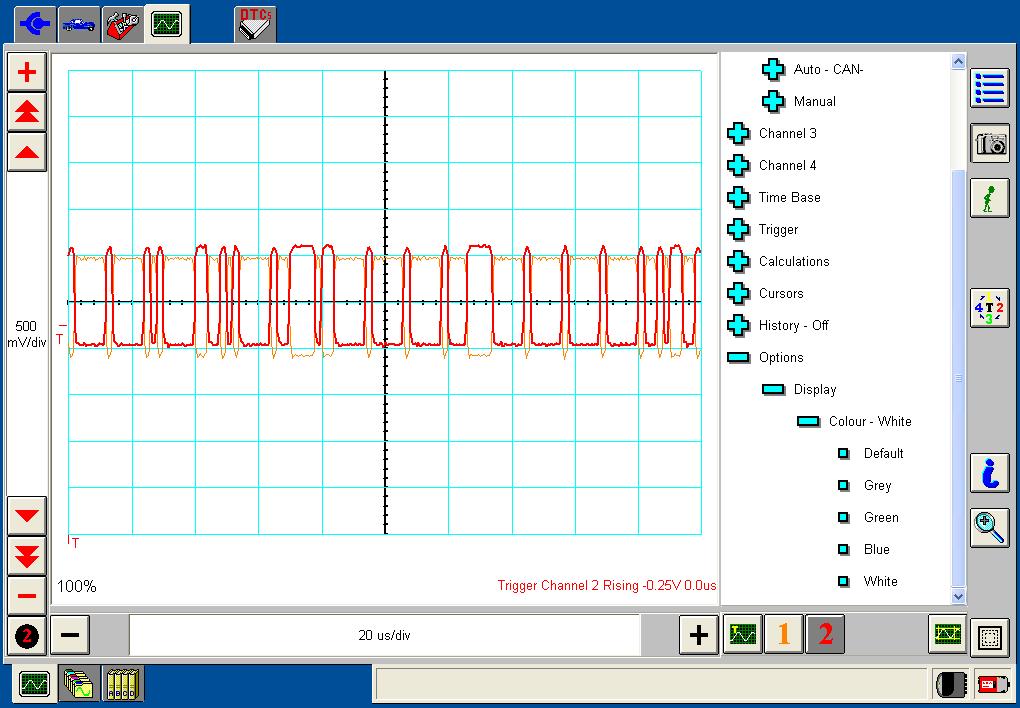
Fuel pump Can + and -signals from a Ford Fiesta 1.4 diesel TDCI 2005
Wiring Diagrams - Information CD's. Are hard to source for late model cars, main franchised dealers tend to be un-helpful on the subject. Trade AutoData books are handy, but expensive for a whole set. AutoData CD-3 version, is very good at £795 ish a year, but even at that price it does not cover everything and it contains errors. Vivid Workshop Data CD1-3 is limited, but is only available as part of a diagnostic equipment package now, but it contains IME repair times which are a bit more realistic than AutoData repair times. Bosch ESi, contains loads of irrelevant information, is very expensive & not worth the money. Most WIS-TIS type CD's advertised on eBay tend also to be a disappointing waste of money. AutoData have in 2007 supported by the Trading Standards, started prosecuting garages in the county of Norfolk for using pirate copies of their product. AutoData 2008 Version 3.24 came with USB encrypted dongle, which did not end their decade old problem of pirate copying. Copies are available via bit torrent over the internet, if you are willing to break the law. Personally I think AutoData CD-3 is a bit over priced, but in their defense, its a very expensive and time consuming process collating and buying the information from motor manufacturers. Maybe if more people bought AutoData's products instead of using pirate copies, they would lower the asking price? Maybe-Maybe not...? (31-10-11) Autodata are now, marketing lower spec ranges of there CD packages, less info for less money! Good idea to me, saves you buying something you don't need.
Other usefull automotive programs include, Vivid and Tollerance which are more aimed at the Euro market than the UK.
Peter Coombes Mototek books at £40 each are very good! Three titles now availiable are, Service Light Reset, which I own and is very handy! Plus Code Breaker, which I borrowed from a friend and was worth a read and have subsequently bought. The third book called Socket Location which I use everyday, I got from eBay for £25 inc P&P (28-11-10)
Don't discount Haynes Techbooks. I have purchased, Engine Management and Fuel Injection Systems Pin Tables and Wiring Diagrams TechBooks Volume 1 Alfa Romeo to Mazda & Volume 2 Mercedes to Volvo, at £25 each and have been very-very pleased with the content. Haynes Automotive Service Summaries TechBook (New Edition) is not worth buying, as it only cover 80 models of cars up to 1999. Link to Haynes website.
Google diagnostics. I Google everything I am not sure of on the internet. Last week I did BMW door lock, I was struggling. After looking on the internet, I found a YouTube video explaining how do it! The art of looking thru the internet is to take "probable cause" suggestions on forums with a pinch of salt. Only take notice of fix postings with pictures. (23-03-14)
Inductive amp-meters are very useful for testing charging circuits, alternator output, battery drain, glowplug and starter motor diagnostics. These very handy hall effect, clamp type attachments which connect and work on the milli-volt range on your multimeter and are dropping in price all the while. Only the type that will detect DC voltage and thus current in two ranges >60amps and >600amps with manual zero adjustment, will be any use. We have two, one is a Heme 60/600A DC/AC clamp type multimeter, accuracy is about 2-5% or worse. The other is a clamp attachment for the milli-volt range of a normal multimeter or connection to an oscilloscope. This attachment type clamp meter for a mulitmeter/oscilloscope has proven better for cranking amp readings, as you can attach the clamp to the battery leads, position the meter against the windscreen, thus reading the test results while turning the ignition key yourself, needing no assistant, it's an expensive Swiss instrument, so is very accurate but costs the earth, but is excellent for relative compression tests in straight four or six cylinder engines (ie. starter motor current waveform amplitude for each cylinder, less current used = the less compression it has). Inductive meter attachments sensitive enough to perform readings on ABS wheel sensors are available for connection to the most expensive scopes, but for use you get from them, they are not cost effective. Picoscopes have now started selling a DC 20>Ma to 60amp DC inductive clamp for £80 + vat/p&p with 4mm connectors or £100 + vat/p&p with a BNC connector, sensitive enough for injectors coils, primary ignition circuits (15-04-07).
 Inductive Amp Clamp
Inductive Amp Clamp
Service Light reset. You will need these for VAG, BMW, Volvo & Mercedes. VAG-COM will reset all VAG service lights. Draper tools supply the cheapest handheld kits £33ish. Draper kits will enact light reset on both new square and old round diagnostic plugs. Most modern professional diagnostic equipment will reset service lights thou. All manual reset instructions are listed in AutoData.
Noid lights. Are history, use a scope or a multimeter set to frequency or even duty cycle. A better option to a noid light is a "logic probe" if the amber light comes on you have a pulse! Maplins sell these for pennys.
Electro-hydraulic brake reset. Laser Tools do a handheld electronic tools for Mercedes and VAG at £125 & £150 retrospectively. Part numbers: Merc- 4311 VAG-4310. Latest version of VAG-COM will enact parking brake reset on VW Passat & Audi A6-A8 models (18-12-07).
Sensor simulators. Forget the expensive offerings from Sykes Pickavant, Snap-on & Mac. Make or find a decade box, for resistance ranges. I own two, a really old Cambridge Audio 0 ohm - 11 kohms with four decades, sourced of eBay for £10. The other is a Ford Granada Scorpio instrument rheostat fitted into a grey plastic IP55 electrical enclosure, with a length of two core cable passed thru a skin top gland. Some expensive purpose made sensor simulators only have fixed resistance ranges. What you are looking for is variable resistance & the ability to adjust the resistance in situ. The Cambridge Audio decade box has fixed steps, thus the need to make a variable load out of a rheostat. Simple tools to make airbag load comparisons against airbag self diagnostics. Most airbag loads are 3.3ohm.
 My Decade Box
My Decade Box
Kal tools make a three channel frequency sensor simulator, called the KM2994. It's for sale from the USA for £35 plus £12 postage. My friend has one and its a useful tool. But if you own a scope and have a bit of confidence, you won't need it! Just test the motion sensor input-output. The KM2994 will drive the ECU with an inaccurate signal, which does not ramp-up with engine speed. But it may get the engine to start, so thus proving a point!
Multimeters. Pick one with a back-light bargraph display, bumpcase, continuity bleeper >40ohm or lower, diode test, fused amps to 10amps DC, autoranging volts AC/DC & ohms, frequency (% duty is handy to), capacitance, polarity indication, hold function with high/low and low battery warning light. Buying a meter with K-type temperature input will save you buying another meter/attachment. Avoid automotive multimeters with dwell angles/percentage and tachometer functions, you just won't use them nowadays, unless you own a classic. Forget moving coil type multimeters, they just draw too much current to be safe to use on modern solid state electronics. Modern automotive multimeters from Summit, Snap-on (Sun), Robin, Sykes Pickavant, Fluke, Mac, OTC, Vetronix & Crypton are very over priced, they offer no advantage, over a non automotive meter, except some offer the addition of pulse-width settings, but if you have a scope you won't need this function. The Robin AR4012 being the best value with this function, at £150 ish. Graphing and storage meters are nice, but really not needed if you own a scope!
My favorite meter for working on cars is my Chauvin Arnoux 5220, they do make a higher spec models numbered 5230-5240, but the 5220 has all the functions I need, no less-no more! The design (5220) was bought up by Facom and the current model number: 711, is in the Facom catalogue at £130. But the same meter is available, cheaper from France direct from Chauvin Arnoux's website with a three year guarantee, for £80. Only difference comparred to Facom red one is the £50 less asking price, is the colour and the three times longer guarantee!
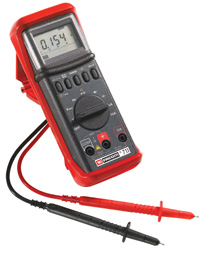 Facom 711 meter £130
Facom 711 meter £130



 My Chauvin Arnoux 5220
£80
My Chauvin Arnoux 5220
£80
I also use a very old tiny Fluke 7-600 auto electrical tester with some really long 3m leads/alligator clips as an audible continuity meter, to save keep changing leads on my other meter, the 7-600 automatically detects AC-DC voltages, above 4.5vac & 1.5vdc when set to continuity, so highlighting any stray or unexpected voltages. On the bench I use a Fluke 23-111. But to be fair, all named meters are very good nowadays, as with most things you only get what you pay for, the meter is going to be the main-stay of all you auto electrical work, so it may pay to buy a little reliability. Wavetech MeterMan multimeters from the USA are a good cost effective alternative to Fluke, Wavetech is the sister company to Fluke. MeterMan meters are red & cheap, Fluke meters are yellow & expensive, but they have the same internal components! Model number: 34XR at £84 (19-04-07) would be the one I would choose. It has all the functions you need, temp, freq, duty cycle, plus true RMS, they are well designed & come with a smart magnetic hanging adapter built into the bumpcase, downside is, it's only auto-ranging on DC/AC volts, ohms ranges and not the current ranges. Continuity is set at 35ohms, lower than the normal 40ohm setting of Fluke meters, which is a good thing & they have the best back light display I have ever seen on any multimeter, whatever the purchase cost. MeterMan model number 38XR is £120 has all the same functions but is auto-ranging on amps & capacitance as well & it does have a RS232 output for measurement recording using a PC, I would not pay an extra £36 for the privilege, because I would not use it. If money is no object and you want the best, the Fluke 867B graphical multimeter costing £750 ish is the one to buy, it's very accurate 0.025% Vdc & has every function you imagine. One can only dream! If its cheap accuracy you are after, old 240v powered bench top multimeters from Keithly, Philips, HP etc. are available from eBay for a pittance. True RMS meters below 0.5% are expensive, and the accuracy is wasted unless you are delving into the internals of ECU's. Learn and understand Ohms Law, grasp the concept of quickly estimating volt-drop from load in circuits. It will save you hours in probing, connecting leads and making adapters.
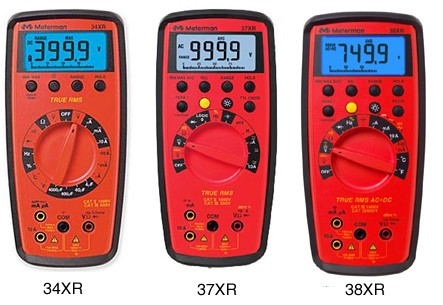 MeterMan 34XR £80
MeterMan 34XR £80
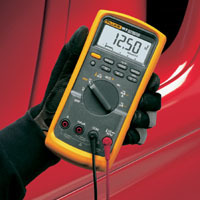
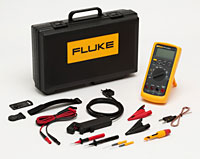 Expensive Fluke 88 meter with pulsewidth function
Expensive Fluke 88 meter with pulsewidth function
Breakout adapters - test leads. Any meter is only as good as its leads, crocodile clip adapters are cheap & free your hands up. A really long set of leads are indispensable for connecting to fuse boxes in a cars bonnet area and positioning the meter facing the windscreen, so you can view the meter screen while operating controls on and around the dashboard. Piercing cable is one of my pet hates, but can't be avoided sometimes. Sharp sewing needles with leads soldered on are far cheaper than purpose made piercing probes. Back probing multi-plugs with auto acupuncture probes is an unreliable method. Making breakout adapters form old multi-plugs (sourced from dead cars), cable, solder & heatshrink tubing, cheaper and a far better idea. If you can't be bothered to make up breakout adapters. Bosch & Sykes Pickavant sell them, Sykes Pickavant part number 300800oo being the cheapest and better made of the two commercially made sets available, set number 30080000 contains two, three, four and five way mini adapters. New male-female multiplugs to make your own leads up can be purchased from Fuel Parts. Most of my breakout adapters are made from piggyback plugs from old-redundant LPG conversion kits. The only thing going for any of the average 14miles of wiring in a modern car is, you can just about estimate the voltages used on any of it. Manufacturers use the thinnest cable possible to save weight and cost, thus volt-drop shows! Most competent auto-electricians will make up a 3m long lead made up of shielded coax with BNC terminals, and a heavy bit of multi-core cable (grey 2.5mm three/four core domestic cable) terminated with 4mm plugs-sockets & cable tied together, to loop from engine bay to main ECU to exclude vehicle wiring when testing sensors in situ for function.
Magnetic compass. Is a very-very usefull tool for auto electrical diagnostics. The simple facts are: electricity causes a magnetic field when traveling thru metals. Most automotive sensors use magnetic fields. All motors use magnets. All solenoids use magnets. All "hall effect sensors" have magnets in them. All standard relays, will deflect a compass when switching. So you can test several types of automotive sensors operation without the need to disconnect the sensor.
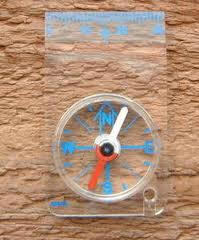 Silva 28
Silva 28
A little home study course for you: Place a silva type compass on the positive cable on your battery, when you activate your starter you will see the compass needle deflect one way, when the starter stops pulling current and the alternator starts putting current back into the battery the compass needle will deflect 180 degrees, as the current flows in the other direction. Also you can use a compass for finding ABS type wheel sensor magnets in hub bearing assemblies.
The best tool for find out problems with ABS magnet wheel bearing assemblies, is a discarded childs Etch-A-Sketch toy. Lay your brand new or used wheel bearing on the screen of the Etch-A-Sketch and see the pattern displayed. With this method you can determine if the bearing is missing any magnetic pickups and they are equally spaced. SKF sell a mini credit card type detector tool for the job.
I have a tiny Silva 28 compass £4.95 it measures 50mm x 30mm (ish) and it is connected to my multimeter leads with a short length of cord. It annoys me, watching people spend £thousands on diagnostic equipment and the most useful tool you can have, is a button compass out of a Christmas cracker.
Power Probes. I hate them! No I really hate them! But they seem to be advertised well by the big automotive tool manufacturers. But in reality who wants to introduce current/voltage into circuits you are unsure of. Anybody who does allot of auto electrical work, will tell you half the time they don't have a wiring diagram and are tracing unknown wiring blind. Plus if you want to see something work, what is wrong with a length of cable two alligator clips and a fuse connected to the battery? Sykes Pickavant sell a probe style mini multimeter called the Terminator, its priced about £80 ish. Its a nice compact thing, but offers no advantage over a multimeter. I do own a really low spec power proble type tool, which changes the polarity from plus to minus. Which I only use for bench diagnostics on electric window regulators and central door locking assemblies.
12V Test Lights. Mine is twenty plus years old. Its a Sykes Pickavant model. I have replaced the high wattage tungsten filament bulb with a very low 60mA 12V LED. Simple soldering job. By reducing the amount of current required to illuminate the test light. It is now safe to use on modern solid state electronics.
Memory Savers. Forget the cigarette lighter type. Buy a Sealey one that goes into the DL16 plus, saves loads of time having to re-programming modules. If you want to make your own memory saver, pin 16 is postive and pins 4 and 5 are negative in DL16 diagnostic plugs. The only reason I made my own, because they were not commercially available at the time I wanted one (could have made a fortune making and selling them maybe).
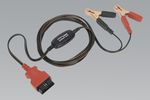
Short circuit detectors. I own one, £15 from eBay, the current Sealey model at £25ish is identical, both are 42V safe and made in China (24-03-08). Mac tools sell one for £45+ which looks exactly the same in the catalogue. They are useful if dealing with large ply-lined vans, minibuses & coaches, to save labour. But for isolating a problem within a harness containing the standard DIN 144 cable-ing, they have very little or no use! They also eat 9v batteries at an alarming rate.
Terminal extraction tools. Most cars are fitted with Pack-Con or Weather-Pack multiplugs with the exception of VAG group cars. Forget Durite multi-type extraction tool. Best type come in sets of twelve or fifteen, Mac tools sell them. My set came from Laser Tools & cost £55ish & I'm very pleased with them (05-09-07). The Laser set even has the new long type in it for the new VAG type multiplugs. I am the only person I know who owns extraction tools & I use them most days. They save allot of money buying & replacing connectors. I also have a set from a local Hyundia main dealers that went bankrupt. These seem to fit all Asian import cars that I can't find tools to fit.
Smoke leak testers. Thinking about making myself one, have used my friends. Its makes orange smoke! Simple as that! Works slightly better than the roll-ups I make (thinking about giving up smoking). While vacuum testing with vacuum testers like a Mityvac or my own homemade, compressed air powered venturi vacuum generator proves leaks against a Hg vacuum gauge. They don't indicate exactly where the leak is like using smoke generator. Still thinking about giving up smoking over a year later (24-03-08). Still smoking, even bought an old Nimrod Commander petrol lighter which is far better than a Zippo (12-03-11). Still smoking (16-10-13). Still smoking (01-02-2015)
![]()
Have today (16-06-08) taken a apart and examined the inner working of a £550 smoke generator which connects to vacuum systems and fills them with smoke to test for leaks. This expensive bit of test equipment works by heating medicinal medical oil (baby oil) with a 12V heating element (diesel glowplug). The smoke generated from this oil was discharged at only 1 PSI (accurate air regulator from a dead spray gun) at a flow of 2-6 LPM litres a minute (tig welding flowmeter). (11-10-09) I have built a smoke testing machine from a glow plug and baby oil, it works very well. Another £550 saved (more beer for me). If you want photos of it, please email me...
(31-10-11) Have today gone backwards with technology for smoke testing. I got a metal bodied Draper 500ml gearbox oil syringe, attached an inline filter on the output pipe, ignitied a plumbers flue smoke pellet, placed it inside. Removed the main vacumn brake pipe on a petrol car. Then I gently pumped the 1/2 litre of dense smoke into the vacumn system and observed the leak. Worked a treat... Smoke pellets are about £1.00 each. Limitations of this method is you only get 500ml of smoke, but that exceeds the volume of most vacumn systems on vehicles. Method worked a treat, I got dense white smoke at low pressure. Now also hunting for a sturdy metal container which has three threaded holes in it, two small for the air in and out, one large to drop the pellet in. So I can pressurize it with a smoke pellet in it. Hopefully I will get more smoke under low pressure with an airline and regulator using this method. Could always use two pellets! I refuse to spend £550 plus on a smoke generator... Also contemplating drilling and fitting a one way type valve on the front of the oil syringe pump so I can get more than 500ml of smoke per pellet, downside will be, while the one way valve is cycling, I would loose positive pressure on the system being tested. If anybody makes a DIY smoke tester, email me some photos. Stimulate my thought process a bit...
(16-10-13) Have today gone forwards with technology for smoke testing. I am there now, £29.95 disco smoke machine ex ebay, 1x 20mm push fit airline adapter with another adapter down to 4mm. Works a treat!
Gas Analysers. Expensive but necessary tool. We have a Ten Innova 2000, which reads HC, CO, CO2, O2 and also calculates lamda (air fuel readings). We have never owned or needed a unit that reads NOX. It also does diesel smoke testing But we never use this function and nor have I bothered to calibrate it up for diesel testing. The big issues with gas analysers is purchase cost and calibration. Our Ten Innova 2000 has a retail price of £5200 + Vat (ouch). We bought it secondhand as a non runner, as we have all our previous gas analysers. But you need to know where to get the spares and how to calibrate any analyser you buy. All MOT spec gas analysers with UKAS calibration "lock out" on the due callibration date. So you either have to enter into an expensive calibration contract with the machine suppliers, which will cost about £700 a year, or do it yourself. Most suppliers will come out for a single cash trip to "un-lock" your machine, for about £150. Then you need to get a bottle of gas from Linde (BOC) which contains CO, CO2, O2 and propane in measured amounts. If you Google calibration gas, there is a company in Cambridge which sells 5lt disposable bottles without incurring any bottle rental. As with any instrument, if you need to trust the readings, it needs to be calibrated correctly. Gas analysers eat pump diaphragms, heated gas bench elements, block filters and the O2 sensors degrade in time. So be prepared to do some spending on a 3-5 year old unit. If I was going to buy a new one, which I am not due to the cost. I would opt for the Boston AGS688 at £1945 from the main retailers at Rainham, Essex. Extra to the purchase, I would buy the optional stand they sell to fit it and some spares, filters, O2 sensor and a pump diaphragm. Bosch sell a model similar to the Boston one, but its silly money. The best secondhand analysers are Sun MGA 1200, but finding a good one, maybe hard work now, as production ended over 15 years ago. Hand held gas analysers like Snap-on Scangas and the offerings from Sykes Pickavant and Kane are just useless toys. One drop of condensation from the warm exhaust gas, into the cold test unit and the readings are all over the place. I hate the cost and aggravation that owning a gas analyser causes me. Even the brand new £7000+ units installed in our local MOT testing bay plays up on a regular basis. If I could get away without owning one I would, but simply put. I need one to diagnose modern engine faults. (09-05-10). Oh... If anybody local to us (PE301PH) has any issues with calibration, I'm abit of a self taught expert on the subject of gas chromatography. Its saved me fortune over the years. Ring me for a chat....
Our Ten Innova 2000
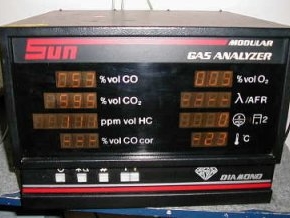 Sun MGA 1200
Sun MGA 1200
IR-RF key fob testers. Red Sealey type tests the newer 800mhz range, I paid £17 + postage from eBay. Some Draper & Sykes Pickavant testers will not handle the new range used in later BMW-VW-Audi-Merc passenger cars (18-07-07). Forget methods based around aiming remote control at mobile phones & digital cameras. Margin of error and subsequent un-needed multiple purchases of batteries and remote control keyfobs is not worth the price of a tester. Always confirm 9V battery inside the tester is up to voltage with your multimeter before using tester. Some testers will show the ready to test-OK light but in fact will not work properly with low internal battery voltage.
Battery load testers. The simplest load tester for checking cell voltage under load is all you want. Most battery testing can be done with a multimeter and using the cars starter motor for a load, to see the Volt drop under load. Or for bench testing, a battery load tester can be made up from a brass bar drilled to accept some diesel engine glowplugs of known value (120amp 4 x 30amp glowplugs) and attach your multimeter set to volt range. For definitive battery performance, an expensive carbon pile load tester rated to 20-180Ah batteries is required. Ours is a 600CCA Bosch T12 200E, it will give an indication of charge state, percentage cold start performance and cell condition. But Sealy at Bury St. Edmunds in Suffolk sell a good value 500CCA model, which shows amps load and open circuit voltage at a given load, which is adjustable. The Sealy model could be used to load test alternators in situ with care. I have just purchased a Midtronics battery tester, as issued to the AA, it was expensive but it is small and light. I'll let you know if its any good? I did not run to the expense of a mini printer to go with it, thought it would be a waste of money. (16-01-11) Had it three months now, its very good, worth every penny! Have now sold the Bosch T12 200E and purchased another lightweight battery tester made by Johnson Technologies (06-05-12).
See charts below: For misleading CCA ratings for differing standards. Most manufactures will quote SAE (EN) rating, making the battery look more powerful in comparison. Most auto battery load testers are calibrated with DIN ratings. Conversion is mathematically near impossible. So choose an auto load tester that has Ah ratings on its scale as well, most battery's have this printed on them. Some battery's are rated by reserve capacity RC not Ampere Hour Ah. See conversion below.
CCA
Cold Start Rating at Ė18oC
| Standard | Duration | End Voltage |
| BS | 60 secs | 8.4V |
| DIN | 30 secs | 9.0V |
| SAE (EN) | 30 secs | 7.2V |
|
|
EN |
IEC |
|
|
155 |
145 |
100 |
90 |
|
200 |
180 |
130 |
110 |
|
250 |
230 |
160 |
140 |
|
300 |
280 |
195 |
170 |
|
350 |
330 |
225 |
200 |
|
400 |
360 |
260 |
225 |
|
450 |
420 |
290 |
255 |
|
500 |
480 |
325 |
280 |
|
550 |
520 |
355 |
310 |
|
600 |
540 |
390 |
335 |
|
650 |
600 |
420 |
365 |
|
700 |
640 |
450 |
395 |
|
750 |
680 |
485 |
420 |
|
800 |
760 |
515 |
450 |
|
850 |
790 |
550 |
480 |
|
900 |
860 |
580 |
505 |
|
950 |
900 |
615 |
535 |
|
1000 |
940 |
645 |
560 |
|
1050 |
1000 |
680 |
590 |
RC Reserve Capacity to Ah rating
Time
in minutes till battery voltage falls to 10.5V with constant load of 25A at +25oC
25
x mins = Ah (ish)
(25 x 1.66hrs <100min RC> = 41.5Ah)
Note on battery sizes and mounting: Most batteries now come in DIN sizes eg: 096, 067, 043. But for bottom clamp mounting, some batteries have removable plastic packing. If you can't get a new battery to fit. Try inspecting the bottom edges of the battery case for packing strips that will lever off with a screwdriver.
Gas powered-240v soldering irons. Are a must for any wiring repair work. Try to avoid crimps as much as possible. Unless using ratchet type crimper to attach them. An extra heavy duty soldering iron (240w) can be made from a pencil glowplug connected to a battery, only use heavy cable to this, as glowplugs pull 20A initially then a constant 10A ish (you want to heat the plug not the cable). Molegrips tend to be the holder of choice. All heavy battery connections should be made using 6mm2/10mm2/16mm2 copper tube lugs and a compatible ratchet type crimper, Screwfix best price for lugs & ratchet. A search on the internet for a small firm called Vehicle Wiring Products in Derbyshire (mail order catalogue), will give you the best supplier for most, run of the mill, connections and modern thin walled insulated cable in small amounts. A Durite catalogue is also handy for designing auto/marine electrical installations. The best de-soldering tool ever is a length of coax cable shielding wire striped out of the insulation and rolled up into a length, dip it in your pool of molten solder and the solder will be sucked up it by a capillary action. Bulb type de-soldering tools are just frustrating to use, plus the end just melts on them. Syringe type de-doldering tools work well, till you melt the nozzle & rendering it useless. My Nimrod gas powered soldering iron has run on cheap lighter gas for years, despite the manufacturers quoting it needs expensive clean butane, it also has a hot air attachment which is handy for heatshrink tubing. Buy good quality 240v soldering irons, Weller is a name that comes to mind. Cheap ones don't last & they also run the risk of earth leakage which damage expensive components. As for wattage, despite what you may think, for repair work on printed circuit boards I use a 40w Weller, and for general wiring repairs I use a 75w Weller. I also own a Draper 25w 12v soldering iron, I have not had too much use out of it. Instant heat 100-150w soldering guns, seem a good idea, but in practice they are just to big & clumsy to use! Master the art of soldering! On your first few attempts it will become obvious you need three hands, one for the soldering iron, one for the solder, one for the wire to be joined on. There is an easy way round this, melt a blob of solder on the end of wire first, then melt a blob on where you want to attach it. Put the reel of solder down, hold the wire in one hand, up to where you want to attach it with one hand, fuse them together with the soldering iron in your other hand, simple! Only use good quality, named make, flux cored solder, its dirt cheap when purchased in 500g 1kg 2kg rolls. For joining allot of wires together on the bench, a solderpot is the best and quickest tool, I got mine from China thru ebay for £12.00, you will need a tin of flux for £2.00. This method is very economical with solder, plus you can melt up all your bits of solder wire which are too short to use with an iron. Wire joints look like they have been done in a factory (this is because it is the way they do it in a factory).
Hot knifes. I have never owned a purpose made hot-knife for cutting open "sealed for life" enclosures/components. Mine is a wooden handled craft knife which accepts standard Stanley knife blades, which I heat up with a propane plumbers torch.
Hot air guns - hairdryers. Cheap hot-air heatguns make a better job of shrinking heatshink, than a cigarette lighter, you'll only end up turning the heatshrink black. Also they are useful for warming up temperature sensors for testing internal resistance. Pipe freezing spray makes a good job of cooling them down. Cold water is not a good choice, you need something that will evaporate quickly. A cheaper option than pipe spray, when used with care, is high flow propane or CO2 from welding bottles. Low wattage hairdryer aimed carefully at a suspect ECU's in situ, can also prove intermittent temperature related faults. I always lay claim to wife-daughters old hair dyers.
DC Bench power supplies. Umm... 12v lead acid battery. For 5v ranges, remove 5v wound coil transformer from a dead ECU printed circuit board & connect to the 12v battery. Don't forget to fuse it, under its maximum output, I have a low cost thermal trip sourced from Vehicle Wiring Products, Derbyshire attached to mine. It would cost me a fortune in fuses, the amount of dead shorts in sensors circuits I find.
Optical/direct contact tachometer. These are very useful for RPM measurements and setting diesel pump over-run speeds. They used to cost the earth but have dropped in price.
Petrol fuel rail pressure testers. Sykes Pickavant make the best, most comprehensive sets, but they cost the earth at £700 plus for a master set. I have a simple Schrader valve tester with a gauge and safety leak off made by Kal. I paid £35 for it. It does the job! I've had to fabricate adapters to connect it to certain systems. But to be honest. I very rarely, if never have to test the rail pressure on cars. It is a tool I could live without. Mostly I just push a small screwdriver into the Schrader valve and if it squirts petrol at me I know there is pressure. Simple really... I now use my petrol pressure tester mostly to test low pressure lift pumps in common rail diesel systems.
Common rail diesel electronic pressure testers. I've seen these for sale. Electronic adapters which connect to the common rail fuel pressure sensor. I do not own one. I always back probe the fuel pressure sensor and view the amplitude of the voltage over time with a scope.
Typical values (Bosch EDC16) Rail pressure sensor.
| Engine stationary | 0.5 volts DC |
| Engine idling | 1.32 volts DC |
| Snap acceleration | 3.77 volts + DC |
Common rail diesel physical pressure test gauge. Sykes Pickavant part no 31465000 (Mine is the Facom equivalent). Pressure gauge that reads upto 1750 bar safety. I paid about £450 for mine, just for the gauge and manifold.. But there is no other method of proving rail pressure switches. Connect gauge from pump to rail, then read off from live data what the electronic readings are, then compare it with the physical rail pressure on the gauge. Expensive tool, but nothing else will do the job. All other connector pips can be souced from dead cars! (01-02-15)
Diesel timing adapters. The below is a later type Sykes diesel adapter with, 30% & 70% trigger points & adjustment, 4mm female jack sockets for connection to a multimeter (voltage) or oscilloscope (waveform), for comparative readings of pressure to injectors, it is also equipped with a memory function from one to eight cylinders. Which makes it a very useful tool for later EDC pumps/injectors. RPM can be measured by connection to a digital timing light equipped for this function. Inductive advanced timing lights with degrees & RPM designed for petrol engines are very cheap now & can be used with this adapter to set dynamic timing advance. I would choose a digital model over an analogue. As analogue models tend to need a higher triggering voltage compared to a digital timing light. I always use handheld optical or direct contact tachometer strobe to set or check idle thou, as my timing light only has degrees. The Sykes adapter can also be used for checking approximate injection advance on common rail systems. This is a better tool than, Sun DIT9000 (Dieseltune DX9000) or Snapon-Mac adapter, as they only measure RPM & advance. It can only be bettered by a handheld CZ Sincro diesel timinglight, which has a built in strobe feedback function as well as comparative readings for common rail systems. The CZ is a smart compact tool, yellow in colour, with only three leads, problem is they cost over £1200 + vat for the base model. All piezo clamp-on-pipe systems can be used for approximate readings of advance on common rail systems, should you be able to find a suitable bit of pipe to the fuel accumulator to attach the adapter.
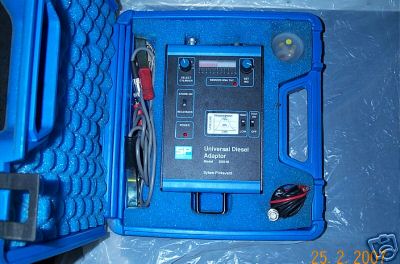 Sykes Pickavant
Part number 300540 (£365 +vat ish) (19-03-07)
Sykes Pickavant
Part number 300540 (£365 +vat ish) (19-03-07)
If its heavy machinery your testing, you will be limited to the Crypton Dieseltune DX9000 system, because its the only one on the market with adapters to fit 8mm & 12mm injection pipe as well as the normal 6mm connections. Dieseltune made a kit for the MOD, the Ministry of Defence kit has an adapter which treads between the injector and injection pipe, I have never used one but have seen them for sale on eBay. There is available from Bosch for heavy marine & industrial diesel engines fitted with large modern EDC inline pumps. A timing system, which works electronically by substituting the crankshaft position sensor & internal pump advance timing sensor with back-probed adapters. It produces via a small handheld control box, a readout of, start of injection in degrees advanced & RPM. This arrangement is far superior to the clamp on piezo injection pipe adapter system. I am at a loss, why Bosch the market leaders, did not equip their small car and commercial injection pumps with this system. Commercially available equipment for this task, fitted with optional inductive threaded sensors, include Bosch ETD-019-02, Sun DIT9000 (now Dieseltune DX9000) & AVC Dieseltester 873. Some of these test systems, will require the adapters to be altered to allow "backprobing" i.e. simultaneous connection to sensor, test instument & EDC control unit. Mercedes fitted a similar system to the legendary 603 engines, circa 1985>94. It worked by connecting a brass threaded sensor into the injection pump side body & governor housing. There is a special Mercedes service tool (part no 617 589 08 2100 ish ???) to read, RPM & start of injection delivery in degrees. The 603 pump gear has a machined slot from the factory, to trigger the sensor. The Mercedes service tool was never made available to the trade or public. Commercially available equipment listed above can be used for this task. Alternatively before the introduction of clamp-on-pipe piezo sensors, Mercedes used a dynamic system, which included a electric spill timing adapter that threaded onto No1 high pressure output pipe on the pump (part no 603 589 00 2100). This system used a hall effect sensor threaded into RSF type governor housing. This test adapter even thou made by Mercedes could be used on any RSF type Bosch inline pump. Commercially available equipment for this task include, Bosch MOT103-002.02-250-301, Hermann D960 or D980, Bear DEACE & Sun MEA 1500.
Alltest - USA (now discontinued) sold a test instrument called the 3900 at very low cost, which was equipped for the same task, but worked in a very different way. By threading a adapter with a hall effect sensor into the governor housing & placing a threaded optical sensor into No1 glowplug port. This allowed, readings of RPM & start of injection delivery in degrees to be calculated by the attached box. This test equipment will work on any Bosch type pump fitted with RSF governor housing. It also does inductive advance-RPM readings on petrol engines, see picture below.
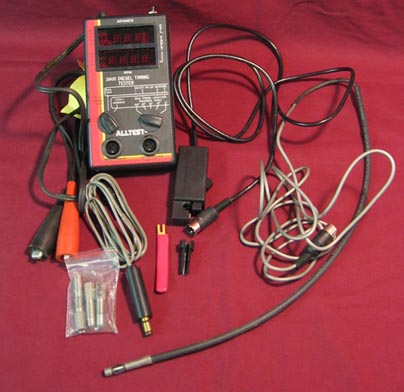 Alltest-USA
3900 (now discontinued)
Alltest-USA
3900 (now discontinued)
Petrol timing lights. With the advent of engine management systems, its a common preconception, a strobe timing light for use with petrol engines, is now of no use now. This is an incorrect assumption. Modern inductive timing lights coming on the market now, such as the CZ Sincro DG86. Are equipped to test, coil in cap plug leads, DIS up to two sparks per rev, volts, advance in degrees & percentage & milliseconds with memory function, RPM plus strobe feedback and automatic ignition & injection advance measurements through TDC sensor. Any inductive timing light with advance & RPM function, will give you peace of mind when changing complicated paired cambelt kits. If you mark up crank & cam pulleys prior to belt removal, then check exact cam timing in relation to crankshaft rotation after fitting a new belt. All four stoke engines unless fitted with variable valve timing have cam pulleys that rotate at twice crankshaft pulley speed, however many cams they have. This is a simple but also a reassuring fact... As with all electronic test equipment, the price will drop of these timing lights in time (19-03-07). Coil in cap systems can be tested by making a test lead up from an old HT lead inserted into the coil cap then attached to the spark plug. For four cylinder cassette coils, you are going to need four (never throw a HT lead away). Forget homemade tin foil amplifiers. They can work, but the results are not reliable enough to condemn expensive components.
Battery chargers. Sealed for life batteries must not be charged over 15.8V, throw your old charger away or buy a automatic one which cuts out at a preset voltage, our Deca professional electronic charger, will charge AGM & flooded lead acid batteries at 15A (RMS low-5A high-10A) it cost £90ish, senses current & voltage, it stops charging at 13.1V, which is a bit low. You can't stop progress thou! (Deca died 06-05-17 after ten years of hard work) But buy one with a manual setting as they mostly work between 9-14v, so if your got a very discharged battery it will not switch on, it will think the battery has a dead cell. If you can't bear to part with your old battery charger, connect a motorbike regulator of known value in the positive charging lead, most bike regulators are set about 14.8V and disperse over-voltage with heat. With an unregulated battery charger, when charging is nearly complete the amps drop but the voltage rises, causing the battery to gas, if too much pressure is created, the seal in battery may break, thus making it a "non sealed for life battery" but one you cannot top up the electrolyte. Cheap 13amp mains plug segmental time-switches are handy to setup non-auto battery chargers for 2-4hr charging sessions, thus avoiding over-charging "boiling" batteries. Very high amperage battery chargers & boost chargers cause heat/distortion of battery plates, anything above 30 amps or charge rates which are above 10-30% of the battery amp-hour capacity, should be avoided. For 8-16Ah small motorbike battery's we use an automatic 1A RMS Beta automatic charger, it stops charging at a more realistic 13.8V.
Should I buy another battery charger today I would choose the Durite 12V-24V 30A bench charger (cost £125ish) it does auto/manual, low charging 3A, high charging 30A & boost at 100A and it has a timer on the front of it. 24V is handy if you have lots of 12V battery's for charging, just connect two in series. Only downside with Durite model is it cannot charge AGM (dry cell batteries) (19-08-10).
I bought another battery charger (08-05-17). The model I purchased was a Bosch C7 (cost £110.00). Reasons being: I wanted a pulse charger for deep cycled batteries. It is wall mounted. It does AGM batteries (which I see allot of now). Plus it does voltage support for programming. Also it has a mode for charging physically cold (low temp) batteries. It has six charging modes and maybe too clever for its own good? Time will tell! It is rated at 7amp 14.4volt. It is as fully automatic as you can get with no manual settings. So I might have to use an old manual charger to get really dead battieres "started" before leaving them to time out on the Bosch C7.
Motorbike/car/lorry batteries can be stored for years without sulfating, if connected to a very low amperage "float charger". These charger's normally cost less than the battery you will destroy over winter due to sulfating, if the battery is left to discharge. Don't believe any sales pitch about deep cycle charge circuits which bring batteries back from the dead, all this does is sell battery chargers not restore batteries into life. Never store batteries on a concrete floor, as the lower temperature from the bottom of the battery causes stratification, which means the acid sinks to the bottom causing extra rate of sulfating to the top of the plates. Store them on two bits of wooden batten of the floor, so allowing a free flow of air and thus even temp of the battery (any storage temp is ok, as long as it even thru the battery). Low maintenance batteries are a better bet than sealed for life batteries, as you can remove the caps, add distilled water & check with a hydrometer. Plus over-voltage charging is possible "gassing them up" in an attempt to remove some of sulfated deposits on the plates in an older battery. Gassing them up means, very low current charge for a very long while, we use an old Davenset 5A RMS 3.3A regulated charger (which tops out at 15.8V) which needs to be supervised regularly, taking hydrometer readings & charging with the filler caps removed. When charging a sulfated battery, the voltage will rise sharply, then fall, then rise again as the sulfation is broken down. So an automated charger is not suitable for this task, it will just cut out. I've never tried any Bat-aid type tablets to restore a battery. I have my doubts if they work! The only thing I have ever added to a battery is distilled water, cooled pre-boiled kettle water as a last resort and electricity. Do not use tap water. Never use sea-salt-water, due to the chemistry of a lead acid battery, you will get chlorine gas expelled from it, when its charging. Avoid marine engine rooms, with batteries installed/charging when flooded with salt water. I nearly killed myself once on a fishing trawler....
Gel & dry batteries (AGM Absorbed Glass Mat) need to be charged at a lower voltage, normal chargers just destroy them! Our Deca charger has a lower voltage setting. AGM battery's are going to be norm', in the future, so if your buying a charger it might be worth paying the extra for one with a lower voltage charge setting. But while flooded lead acid batteries are the norm' I wish I had purchased the above mentioned Durite charger with a timer.
In my experience, 50% of battery's which are thrown away are ok. The fault normally lies with charging system connections. I've inherited hundreds of serviceable battery's over the years from customers who when faced with a flat battery, have just bought a new one. Only to find that the new one, just goes flat due to a charging fault. They never want the old one, ever! They are grateful to get rid of it. All battery's can be stored indefinitely, in a fully charged state. Till you can find someone to sell it to, who actually needs one. For some unknown reason, most people will not entertain a perfectly good secondhand battery even when it has been load tested in front of them! Some people just have too much money!
Leisure battery's have a higher internal resistance to enable them to be recharged/discharged to a lower level than a normal car battery. This also makes them suitable for split charge charging systems, a normal 30amp relay can be used for a split charge system, they are better/cheaper than caravan types, GM relays have well marked Amp ratings on them, they tend to have proper Lucar 1/4" fittings, so connection is easier, don't forget to fuse any live lead from both battery's to protect cable against overheating due to jumpstarting with the engine running, when the relay has made contact. For caravan fridge systems you just need another 30A relay (remember to use min 2.5mm cable to avoid volt drop over distance, your fridge in a caravan could be a long way away from the battery). Never start an engine from a leisure battery, the high current drain, due to the higher internal resistance will just destroy the plates after a few attempts. Leisure battery's will stand a higher charging current without sustaining any damage (as long as they can be vented & topped up).
Approximate indication of a battery's state of charge via open circuit voltage. After allowing battery to rest for a few minutes after charge-discharge. Colder battery's will show a lower open circuit voltage (sub 15˚C
| Volt Reading | Charge |
| 12.7V or over | 100% |
| 12.5V | 75% |
| 12.4V | 50% |
| 12.2V | 25% |
| 12V or nothing | Discharged |
42v batterys. Leoni who make OE wiring harnesses are already developing 42v systems for manufacturers at present for models not yet announced. 42v is going to be the new standard and is based on 3 x 14v. They will use 14v and not 12v as automotive voltage. Itís based on 14.4v peak voltage from three or six phase alternators. Batteries will be same size but have internals the same as three normal batteries. The reasoning is that electrical demand for all the equipment is increasing. The existing 12/14v system means high amps and thicker cables. Of course the trend is for lightweight so going to a 42v system results in thinner cables than a even for a 12v system. This isn't Leoni's decision but an agreement between the various electrical parts manufactures, car manufactures and related industries for it to become the new "standard". Itís likely these systems might involve numerous mini inverters all over the vehicle to drop the 42v down to 14v on the other hand it might just be 42v bulbs etc. (15-01-08) I have not seen a 42V battery or a high voltage charger yet.
Hydrometers. A better way of telling state of charge is hydrometer, if its not a sealed for life battery! Don't forget hydrometers are temperature corrected, normally the scale is set for 15oC, correction is minus 0.007 per 10oC below 15oC and plus 0.007 per 10oC above 15oC. Duralite sell the best hydrometers with temperature corrected scales. Halfords sell a nice dinky glass one in a plastic case, to prevent breakage for £3.99. Avoid plastic hydrometers, diluted acid in the electrolyte kills them. Also avoid the older type with floating plastic balls, they are not very accurate. Any hydrometer's accuracy can be improved in use, by tapping the side of it, to evacuate air bubbles.
A point of interest is, battery's will freeze at a very low temp. But never add distilled water in weather below freezing and use the battery without mixing/agitating the electrolyte. If a layer of the electrolyte is frozen pure distilled water, but the lower layer of electrolyte is diluted un-frozen acid, any discharge will damage the battery plates, due to uneven chemical action. But a completely frozen solid battery can be re-thawed then reused without sustaining any ill effects. Warm battery's always perform better than cold ones. But avoid electrolyte temperatures above 42oC.
Jump Leads. Jumpleads should be made up from < 352 welding cable or thicker and thus rated up to 600A. Screwfix sell 600A set cheaper than you can make them. Short, thick jumpleads are what you're looking for. Considerable damage to car electronics can be caused by jump starting from a slave battery connected to a running vehicle with the host alternator peaking to 14.8v. Tow starting damages the CAT by un-burnt fuel entering it. Best advice is to charge the battery up! Or buy an anti-voltage surge device. Despite the common advice about earth connection when jumpstarting. Connecting direct to the battery terminal should be the norm, to stop stray high current passing thru non returned earth sensors and semi-conductors. All AA vans have a second battery powered by a split charge relay when the van is running. This second battery is disconnected from the vans wiring, so its a stand alone battery when the patrolman jump starts a stranded motorist. They do not use van's battery.
Cable ratings at 12V, mm≤ quoted is for cable conductor excluding insulation. Cable ratings drop when cables are "bunched" and subjected to heat.
1 mm≤ 8.75
amps
2 mm≤ 17.5 amps
3 mm≤ 27.5 amps
4.5 mm≤ 35 amps
6 mm≤ 42 amps
7 mm≤ 50 amps.
8.5 mm≤ 60 amps
10 mm≤ 70 amps
Engine starters. Modern lightweight jumpstarting powerpacks cost the earth, I made one from an Odyssey PC680 drycell battery, this battery can provide 680 cranking amps for 5secs, it only weights 7kg. The rest of the design is two short 25mm squared leads, 600amp red and black crocodile clips, cable ties and abit of hose pipe for a handle. I use my battery charger to top it up. Also get a 105ah 770cca or bigger 12v lorry/tractor battery instead, you can turn over a non starting diesel van or 4x4 for a very long while, plus the lorry battery will last for years if stored in a fully charged state. I think my Exide lorry battery is over 15yrs old. The only downside is, its heavy. Warning: The 24v ranges on jumpstarting powerpacks destroy 12v vehicle electronics. I've had to repair many vehicles which have been "24-volted" over the years. These include: A Citroen Berlingo van, which destroyed the £800 electronic diesel pump. A big Cummins 4x4 truck which got 24 volted from a forklift when it was being imported from the USA it did not even get off the docks at Harwich. The last one was a 6 month old £34k VW Touareg 3.0 V6 Tdi tiptronic auto, the parts bill for the repair was over £4k without labour.
Warning: Never-never use a cheap unregulated, no-name wound coil engine starters made in the far east, big heavy things on wheels which double as battery chargers, most of them have output voltages at the higher end of the amperage curve which destroy car electronics. We think these account for about one in three of all ECUs we sell. You have been warned. A humble lorry battery has a discharge voltage curve which starts at 13.8v and drops on high current delivery. I have a huge Snap On fast charger on wheels, I only ever use it as a fast battery charger, I never-never use it for engine starting. Its far safer to show a bit of patience and wait ten minutes or so to bulk charge a flat battery.
Lead lights. Modern 76 LED cordless lead lights are all very good. We have a yellow 12V 13W florescent lead light made by Sealy which works well and has lasted years, its in our recovery truck, anything rechargable is always flat in the truck. Also we have a Dewalt 13W 12-14.4V florescent light for use with 12-14.4V cordless drill batteries, this lasts about 3hrs with a fully fully charged 12V 3.0Ah NiMh battery. We have purchased several non genuine, made in China Dewalt compatible replacement batteries and they all work very well at about 30% of the cost of the genuine item. Normal 240V lead lamps fitted with low energy bulbs are OK but very fragile. They don't generate heat, which gets unpleasant when working close to normal tungsten filament bulb. I have purchased two 15 LED cordless lamps made by Ring (16-06-09) at £30 each they are super light weight tools, they seem to keep the charge for ever. They are a bit fragile, one of them has already been glued together with chemical metal. With the advent of the LED I have started to use a AA maglight torch for work now fitted with them, it does not use too many batterys.
The point I have been trying to make above is. If you equip yourself up for every job that comes your way. You will have spent more money on equipment than you can earn.
Common Rail Dummy Injector. For use with Sykes, Snap on, Mac, Facom or Sealey compression tester kits! (There are two types of compression tester gauges on the market, this dummy injector is for use with the more expensive sets that have a one way valve fitted in the gauge connection pipe). These dummy injectors are made by Eland-Zeca in Italy. This is the only company who make them! Using one of these is a far better idea than snapping glowplugs to get access to the cylinder for compression testing. The dummy injector has two adjustable lock rings so you can match the clamp height. You need to use the seal off the injector you have removed.
advice on trade garage equipment
welding/equipment + shielding gas info


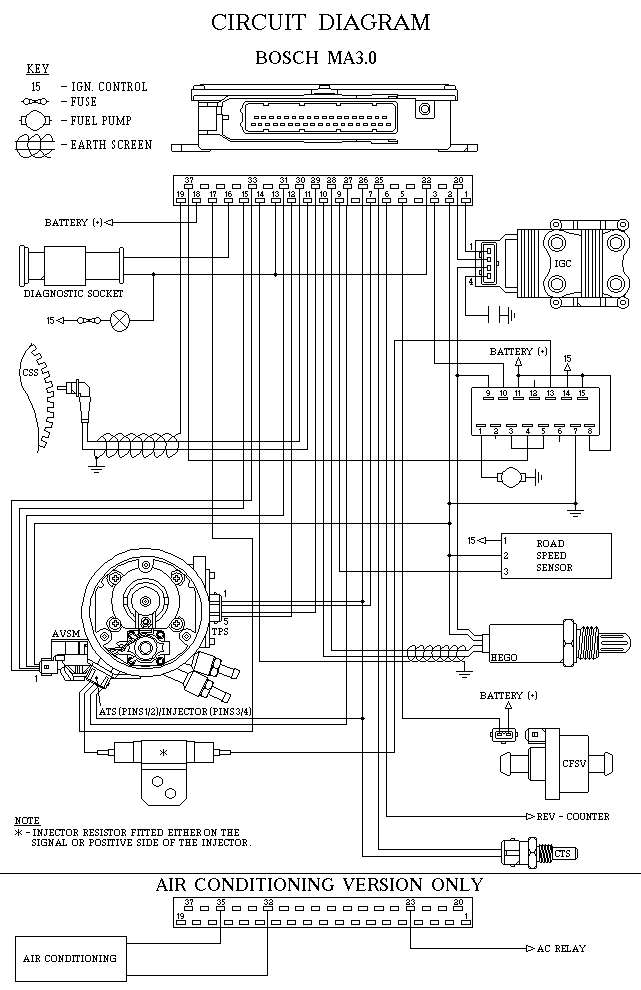
(date information written)
![]()